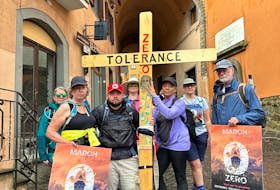Thursday morning, Jenkins and his fellow paramedics with Western Health were present at Western Memorial Regional Hospital to hear the Western Regional Hospital Foundation announce its 2015-2016 case for support.
The group was pretty interested in the announcement because, of the $592,555 it wants to raise, $165,000 will go to purchase a new four-wheel drive ambulance for the emergency department.
After the event, Jenkins said the hospital has a four-wheel drive ambulance now, but it’s about at the end of its lifespan.
“There’s been times that we haven’t had our four-wheel drive and we haven’t been able to get to a call,” he said.
At those times the hospital has to turn calls over to a local private operator that has a four-wheel drive vehicle. But that’s not always an ideal option as two calls could come from the same area.
“Then you’re up the creek,” said Jenkins.
The geography of the area alone makes the vehicle a necessity.
“You’re either up the side of one hill or down the side of another hill,” he said. “It’s just challenging to get there without a four-wheel drive.”
Jenkins said one of the worst areas he’s had to go in was Serpentine Lake — more than 30 kilometres of woods road with ruts about two-feet deep. It can be a challenge to get in and get back out, but if a helicopter isn’t available, Jenkins said the four-wheel drive is needed.
The new ambulance will also be a safety concept vehicle with an improved loading system.
Jenkins said Western Health has upgraded to hydraulic stretchers that cut down on the lifting of patients, and the new ambulance will extend on that. It will have an arm that comes out, clamps onto the stretcher and lifts it into the vehicle, further decreasing the amount of manual lifting.
“It saves a lot of backs. It saves a lot of people off injured.”
There’ll also be a safety component on the inside as the chairs for the paramedics will be on a slide system allowing them to move back and forth and rotate, giving them access to patients without having to get out the seatbelt.
“That’s always been a risk, to be up moving around in the compartment, trying to do CPR, trying to start IVs, do EKGs on patients when you’re moving.”
Money raised in 2014-2015
$404,546.98
Goal for 2015-2016
$592,555
Equipment list for 2015-2016
Barco mammography monitor — $76,963
Cardio ultrasound unit — $282,500
Bariatric stretcher/wheelchair — $14,916
2 patient floor lifts — $26,000
Portable ultrasound for hemodialysis $10,676
Bladder scanner — $16,500
Ambulance — four-wheel drive, safety concept — $165,000
Thursday morning, Jenkins and his fellow paramedics with Western Health were present at Western Memorial Regional Hospital to hear the Western Regional Hospital Foundation announce its 2015-2016 case for support.
The group was pretty interested in the announcement because, of the $592,555 it wants to raise, $165,000 will go to purchase a new four-wheel drive ambulance for the emergency department.
After the event, Jenkins said the hospital has a four-wheel drive ambulance now, but it’s about at the end of its lifespan.
“There’s been times that we haven’t had our four-wheel drive and we haven’t been able to get to a call,” he said.
At those times the hospital has to turn calls over to a local private operator that has a four-wheel drive vehicle. But that’s not always an ideal option as two calls could come from the same area.
“Then you’re up the creek,” said Jenkins.
The geography of the area alone makes the vehicle a necessity.
“You’re either up the side of one hill or down the side of another hill,” he said. “It’s just challenging to get there without a four-wheel drive.”
Jenkins said one of the worst areas he’s had to go in was Serpentine Lake — more than 30 kilometres of woods road with ruts about two-feet deep. It can be a challenge to get in and get back out, but if a helicopter isn’t available, Jenkins said the four-wheel drive is needed.
The new ambulance will also be a safety concept vehicle with an improved loading system.
Jenkins said Western Health has upgraded to hydraulic stretchers that cut down on the lifting of patients, and the new ambulance will extend on that. It will have an arm that comes out, clamps onto the stretcher and lifts it into the vehicle, further decreasing the amount of manual lifting.
“It saves a lot of backs. It saves a lot of people off injured.”
There’ll also be a safety component on the inside as the chairs for the paramedics will be on a slide system allowing them to move back and forth and rotate, giving them access to patients without having to get out the seatbelt.
“That’s always been a risk, to be up moving around in the compartment, trying to do CPR, trying to start IVs, do EKGs on patients when you’re moving.”
Money raised in 2014-2015
$404,546.98
Goal for 2015-2016
$592,555
Equipment list for 2015-2016
Barco mammography monitor — $76,963
Cardio ultrasound unit — $282,500
Bariatric stretcher/wheelchair — $14,916
2 patient floor lifts — $26,000
Portable ultrasound for hemodialysis $10,676
Bladder scanner — $16,500
Ambulance — four-wheel drive, safety concept — $165,000








